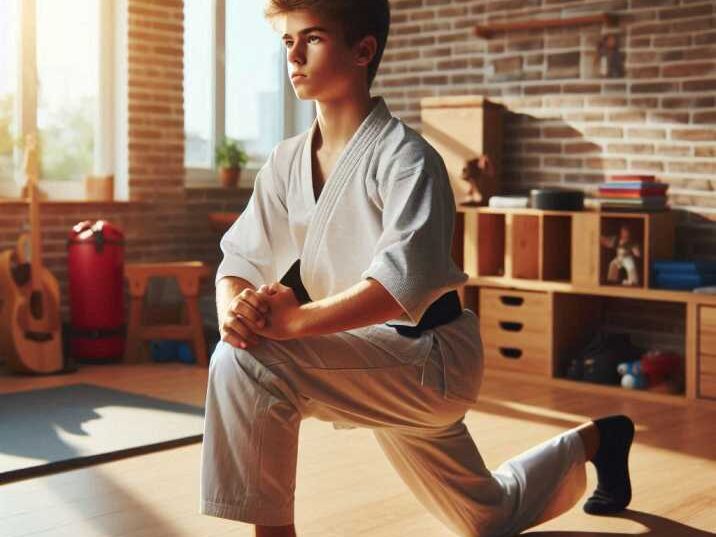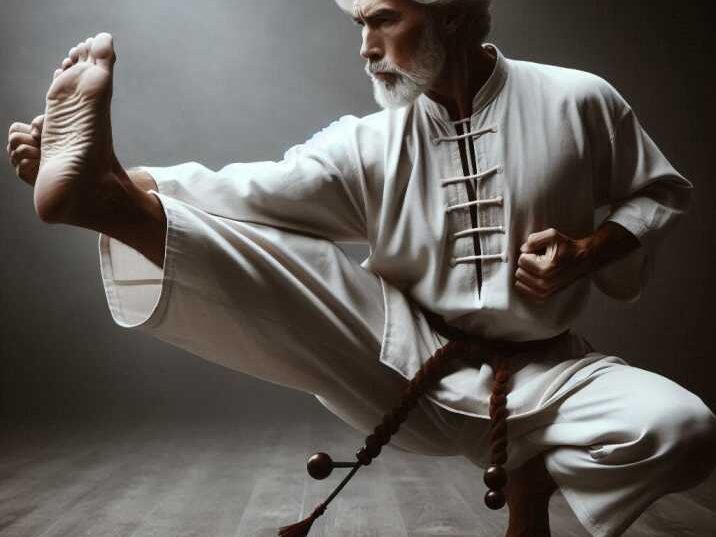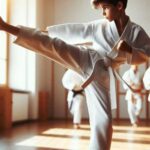Introduction
Table of Contents
What is Hung Gar?
Hung Gar, also known as Hung Ga, is a traditional Southern Chinese martial art. It combines powerful stances, swift strikes, and intricate forms, making it a popular choice for those interested in self-defense, fitness, and discipline. If you’re curious about how to learn Hung Gar, this guide will take you through the essential steps and provide all the information you need to start your journey. Whether you’re a beginner or just interested in learning more, this guide is perfect for you!
1. Understand the Basics of Hung Gar
What Makes Hung Gar Unique?
Hung Gar is unique because it blends strong stances with fluid movements, imitating the strength and grace of animals. This martial art focuses on building internal energy, known as Chi, while enhancing physical strength.
Key Principles of Learn Hung Gar
- Strong Stances: Hung Gar emphasizes deep and strong stances, like the Horse Stance, which helps build leg strength and balance.
- Animal Forms: Movements in Hung Gar often imitate animals like the Tiger and Crane, teaching practitioners to balance power with agility.
- Breathing Techniques: Proper breathing techniques help harness internal energy and improve stamina.
2. Find a Hung Gar School or Instructor
Why You Need a Qualified Instructor
Learning Hung Gar from a qualified instructor ensures that you master the correct forms and techniques. A good instructor will guide you through the complex moves and help prevent injuries.
How to Choose the Right School
- Location: Find a school close to your home for convenience.
- Reputation: Look for schools with good reviews and experienced instructors.
- Class Size: Smaller classes allow for more personalized attention.
Online Learning Options
If a local school isn’t available, there are online platforms where you can learn Hung Gar through videos and virtual classes. However, be cautious, as learning martial arts without a teacher’s supervision can be challenging.
3. Start with the Fundamental Stances
Important Stances in Hung Gar
Mastering the basic stances is crucial in Hung Gar. These stances form the foundation of every move and are key to developing strength and balance. Below are the essential stances you need to learn to build a solid base in Hung Gar:
1. Horse Stance (Ma Bu)
- Description: The Horse Stance, also known as Ma Bu, is one of the most iconic and fundamental stances in Hung Gar. This stance requires you to stand with your feet wider than shoulder-width apart, your knees bent, and your thighs parallel to the ground, as if you are sitting on an invisible horse. Your back should be straight, and your arms either at your sides or in front of you, depending on the specific technique you are practicing.
- Purpose: The Horse Stance is excellent for building leg strength and stability. Holding this stance for extended periods strengthens the quadriceps, glutes, and calves. It also teaches you how to maintain balance and center your weight, which is essential for executing powerful strikes and staying grounded during combat.

2. Bow Stance (Gong Bu)
- Description: The Bow Stance, or Gong Bu, involves stepping one leg forward into a deep lunge position, with the front knee bent and the back leg extended straight behind you. Your front foot should be pointed forward, while the back foot is angled slightly outward. The torso remains upright, and your weight is evenly distributed between both legs.
- Purpose: This stance is designed to enhance mobility and striking power. The Bow Stance allows for quick transitions between offensive and defensive movements. It also strengthens the legs and improves flexibility in the hips, making it easier to generate force for punches, kicks, and other techniques. Additionally, the stance helps with forward momentum, enabling powerful lunges and advances toward an opponent.
3. Cat Stance (Mao Bu)
- Description: The Cat Stance, or Mao Bu, is a light and agile stance where most of your weight is placed on the back leg, with the front leg barely touching the ground. The front foot is positioned lightly on the ball of the foot, ready to move or kick at a moment’s notice. The body is kept low, and the hands are often held in a guard position in front of the chest.
- Purpose: The Cat Stance is essential for developing agility and quickness. Since most of the weight is on the back leg, it allows for rapid movement and quick changes in direction. This stance is particularly useful for evasive maneuvers, quick strikes, and surprise attacks. It teaches you to stay light on your feet and ready to react, making you more unpredictable and difficult for opponents to read.
4. Learn the Basic Forms
Once you’ve mastered the basic stances, it’s time to move on to learning the forms in Hung Gar. Forms, or “katas,” are sequences of movements that simulate combat against imaginary opponents. These forms help you practice the stances, strikes, blocks, and transitions in a fluid, continuous manner.
Beginner Forms to Practice
- Gung Ji Fook Fu Kuen (Taming the Tiger):
- Description: This form focuses on strength and endurance, teaching you how to control your power and use it effectively. It involves strong stances, forceful strikes, and deep breathing techniques.
- Purpose: This form helps develop physical strength and mental discipline. It teaches you how to tame your inner energy (Chi) and direct it towards powerful, controlled movements. It’s often considered the foundation of Hung Gar and is one of the first forms taught to beginners.
- Fu Hok Seung Ying Kuen (Tiger and Crane):
- Description: The Tiger and Crane form is a blend of aggressive, powerful movements (Tiger) with graceful, fluid motions (Crane). It teaches balance, coordination, and how to combine force with finesse.
- Purpose: This form is designed to teach you how to balance power with agility. The Tiger movements emphasize raw strength and attacking force, while the Crane movements focus on defense, precision, and evasiveness. Mastering this form will improve your ability to switch between offensive and defensive techniques seamlessly.
By practicing these forms regularly, you will not only improve your technique but also develop a deeper understanding of the principles behind each movement. The forms teach you how to apply the stances and techniques you’ve learned in real-life situations, making your training more practical and effective.
What Are Forms in Hung Gar?
Forms are sequences of movements that simulate combat against imaginary opponents. They teach coordination, balance, and how to apply techniques in real-life situations.
Beginner Forms to Practice
- Gung Ji Fook Fu Kuen (Taming the Tiger): A fundamental form that focuses on strength and endurance.
- Fu Hok Seung Ying Kuen (Tiger and Crane): A popular form that combines power and grace, imitating the movements of a tiger and crane.
5. Practice Breathing Techniques
Importance of Breathing in Hung Gar
Proper breathing techniques are essential in Hung Gar to control your energy and improve endurance. Learning how to breathe correctly will enhance your performance and keep you focused.
Basic Breathing Exercise
- Inhale deeply through the nose, expanding the abdomen.
- Exhale slowly through the mouth, tightening the core.
- Practice this while holding different stances to improve Chi flow.
6. Focus on Strength Training and Flexibility
Strength Training for Hung Gar
Hung Gar requires a lot of physical strength, especially in the legs and core. Incorporating strength training exercises, such as squats, lunges, and push-ups, will help build the necessary muscles.
Flexibility Exercises
To perform the high kicks and swift movements in Hung Gar, flexibility is key. Stretching exercises like leg swings, hip stretches, and yoga can improve your flexibility and prevent injuries.
7. Apply Hung Gar Techniques in Sparring
Why Sparring is Important
Sparring allows you to apply the Hung Gar techniques you’ve learned in real-life scenarios. It helps you develop timing, reflexes, and the ability to defend yourself against an opponent.
Tips for Safe Sparring
- Wear protective gear.
- Start slow and focus on Hung Gar technique rather than speed.
- Always respect your partner and avoid causing injury.
Table of Information: How to Learn Hung Gar?
| Topic | Description |
|---|---|
| Stances | Horse Stance, Bow Stance, Cat Stance |
| Forms | Gung Ji Fook Fu Kuen, Fu Hok Seung Ying Kuen |
| Breathing Techniques | Deep breathing, core tightening |
| Strength Training | Squats, Lunges, Push-ups |
| Flexibility Exercises | Leg swings, hip stretches, yoga |
| Sparring Tips | Wear protective gear, focus on technique |
| Finding a School | Look for qualified instructors, consider online options |
Conclusion:
Learning Hung Gar is a rewarding journey that combines physical strength, mental discipline, and cultural tradition. By following the steps outlined in this guide, you can begin your training with confidence, knowing you have a solid foundation. Remember, patience and dedication are key to mastering any martial art. Keep practicing, stay focused, and enjoy the journey!

5 FAQs About Learning Hung Gar
- Can I learn Hung Gar at home?
- Yes, you can start with online classes, but having an instructor is recommended for proper guidance.
- How long does it take to learn Hung Gar?
- It varies, but mastering the basics can take a few months to a year with consistent practice.
- Is Hung Gar suitable for kids?
- Yes, Hung Gar can be practiced by kids and helps in developing discipline and physical fitness.
- Do I need any special equipment to start Hung Gar?
- Basic training requires no special equipment, just comfortable clothing and space to move.
- What are the benefits of learning Hung Gar?
- Benefits include improved strength, flexibility, self-defense skills, and mental focus.


